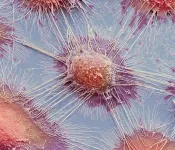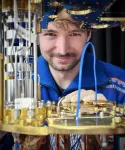Middle molecules with a molecular weight of more than 1,000 are difficult to synthesize due to multiple steps and time-consuming nature, demanding the development of a new approach that can overcome these disadvantages. Click chemistry has become an essential tool in applied chemistry due to its simplicity, efficiency, and versatility. This approach to chemical synthesis allows for quick and reliable joining of small molecules into larger, more complex structures, often with minimal side reactions and byproducts. By definition, click chemistry reactions are highly selective and efficient, making them ideal for creating specific compounds in a controlled and predictable manner.
By taking this idea two steps further, chemists have been developing molecular platforms that allow for triple click chemistry—the development of stable molecules with three different functional groups that serve as distinct, targetable reaction sites. Although these “trivalent” platforms enable the efficient synthesis of complex compounds, the selective formation of triazoles using platforms with azide and alkyne moieties remains an unsolved challenge.
Against this backdrop, a research team led by Associate Professor Suguru Yoshida from Tokyo University of Science (TUS), Japan, set out to develop novel trivalent platforms capable of producing highly functional triazoles. The team ensured coordination with the United Nations’ sustainable development goals (SDGs)—SDG 3 (good health and wellbeing), SDG 7 (affordable and clean energy), and SDG 9 (industry, innovation and infrastructure). This study, which was published in Chemical Communications on January 7, 2025, was co-authored by Mr. Takahiro Yasuda, a master’s degree student, and Mr. Gaku Orimoto, who completed a master’s degree in 2023, both from TUS.
The researchers succeeded in creating stable trivalent platforms for triple click chemistry, thanks to a longer linker in the central scaffold. The research team demonstrated how a wide variety of molecules could be produced by sequentially targeting each functional moiety in the trivalent platform. For example, they leveraged the sulfur–fluoride exchange reaction to target the fluorosulfonyl moiety and produce different alcohols in high yields without affecting the azide and alkyne moieties. Then, they performed diverse transformations on the azide moiety, including hallmarks like copper-catalyzed azide–alkyne cycloaddition, strain-promoted azide-alkyne cycloaddition, and Bertozzi–Staudinger ligation. Finally, through a broad range of possible third transformations targeting the remaining alkyne moiety, the researchers successfully synthesized complex triazoles.
Notably, it was not strictly necessary to follow the order described above when targeting each moiety, as the researchers demonstrated triazole formations selectively in subsequent experiments. On top of this, complex triazoles could be obtained in a straightforward, one-pot reaction. “Selective click reactions with molecules that have both azide and alkyne moieties are not easy, but we were able to elucidate that each click reaction proceeds in a highly selective manner by properly choosing alkyne or azide reaction partners that react preferentially with the targeted group under the suitable conditions,” explains Yoshida.
The triple click chemistry platforms developed in this study have important implications in several applied fields. For example, functionalized multi-triazoles, which can be readily prepared in high yield, are valuable in drug development, material science, and bioengineering. They are compatible with many biological targets, such as enzymes and receptors, indicating potential pharmaceutical applications. The bio-active middle molecules synthesized via triple click chemistry can help in recovering from intractable diseases. Moreover, they are important in catalysis and materials development, serving as the basis for the design of polymers, sensors, coatings, and coordination frameworks.
“Our ultimate goal is to create new molecules that will revolutionize life sciences, and we conceived this research as a method for assembling simple component molecules all at once,” concludes Yoshida. “The proposed method enables the simple synthesis of multifunctional molecules and a wide variety of medium-sized molecules, and we expect it to be widely useful in pharmaceutical science, medicinal chemistry, chemical biology, and materials chemistry.”
The proposed approach utilizes simple initial materials rather than complex materials, promoting sustainable pharmaceutical synthesis. Additionally, the time-saving aspect of this approach can speed up the research process. Overall, the efficient trivalent platform molecules presented in this study will help accelerate progress toward more sustainable chemistry, hopefully leading to green synthesis protocols, better medical treatments, and environmental and agricultural advancements.
***
Reference
Title of original paper: Three-step click assembly using trivalent platforms bearing azido, ethynyl, and fluorosulfonyl groups
Journal: Chemical Communications
DOI: 10.1039/D4CC06585A
About The Tokyo University of Science
Tokyo University of Science (TUS) is a well-known and respected university, and the largest science-specialized private research university in Japan, with four campuses in central Tokyo and its suburbs and in Hokkaido. Established in 1881, the university has continually contributed to Japan's development in science through inculcating the love for science in researchers, technicians, and educators.
With a mission of “Creating science and technology for the harmonious development of nature, human beings, and society," TUS has undertaken a wide range of research from basic to applied science. TUS has embraced a multidisciplinary approach to research and undertaken intensive study in some of today's most vital fields. TUS is a meritocracy where the best in science is recognized and nurtured. It is the only private university in Japan that has produced a Nobel Prize winner and the only private university in Asia to produce Nobel Prize winners within the natural sciences field.
Website: https://www.tus.ac.jp/en/mediarelations/
About Associate Professor Suguru Yoshida from Tokyo University of Science
Dr. Suguru Yoshida is an Associate Professor at the Faculty of Advanced Engineering, Department of Biological Science and Technology, Tokyo University of Science, Japan. He received his B.S. and M.S. degrees from the University of Tokyo. After earning his Ph.D. in engineering from Kyoto University (2009), he held postdoctoral positions at Kyushu University and the University of Hawaii, and was an Associate Professor at Tokyo Medical and Dental University. He has received several awards, including the Thieme Chemistry Journals Award and the Young Generation Special Lecture Award, and has published over 100 articles with 4,000 citations in synthetic organic chemistry and chemical biology.
Funding information
This work was supported by JSPS KAKENHI Grant Number 23K179200 and the Asahi Glass Foundation.
END






